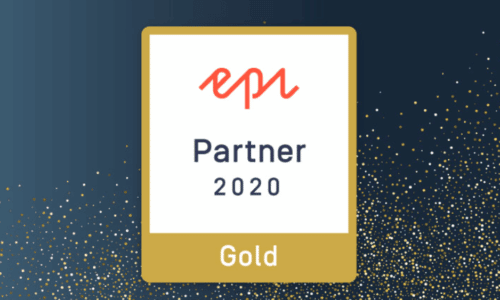B y collaborating with a partner with deep experience in the software platform you are implementing, both teams gain access to the others’ skill sets, experience and viewpoints, which can greatly expand the scope of success.
Sonny and Cher. Bert and Ernie. Peanut butter and jelly. A lot of good things come in pairs and business relationships are no exception. In the software industry, what’s more important than just having good business ideas is having a trusted and experienced systems integration partner to help implement them.
I’ve been with BlueBolt for almost 15 years, and in this business even longer. Over time, I’ve learned what it takes to have a successful digital engagement that is delivered on time and on budget; it takes every member of the project team, including client stakeholders, to all work towards the same goals and be on the same page.

Yes, as professionals, we can take instructions and follow them exactly as outlined by our clients, but we understand that the quickest and easiest way to get results is through open and frequent communication as a team. While we pride ourselves on being expert strategists, developers and consultants, we know we can’t achieve our goals without making sure we’re helping our clients effectively achieve theirs throughout every step of their projects. It truly “takes two to make a thing go right.”
Be Prepared
Benjamin Franklin wisely said, “By failing to prepare you are preparing to fail.” As a client, when it comes to starting a project and getting through discovery, UX and creative on budget, it’s important to be prepared by looking at the project holistically. At BlueBolt, we do this by providing our clients with highly detailed documentation to complete well in advance of discovery in order to anticipate and address any roadblocks or issues that may arise throughout the project timeline.
In order to understand the importance of this and why our engagement model makes such a difference, I’ve outlined some differentiators of our process here in this blog post. I believe you’ll see just why what we do at BlueBolt is so important to our clients’ success and how following our model translates into better outcomes for all involved.
The Discovery Package
Before the discovery portion of a client engagement starts, our team will send a discovery package – a detailed document of questions – to our client. This document is meant to help the client prepare for the discovery engagement and is based off a standard template but is always tailored to each specific project. The discovery package includes questions that cover the whole gamut of what objectives the client wants and needs to accomplish by running their project and what’s expected of us as their partner.

Our clients complete this documentation and send it back in time to be reviewed before the discovery meetings start. This enables our project team to focus on areas of weakness and uncertainty and can really help streamline the discovery process.
We believe this discovery package helps the client in two ways:
- It prepares the client to consider the topics and questions that need to be discussed so the client can either provide the answers ahead of time or come prepared to discuss the answers during the discovery meetings.
- It also helps the client identify the stakeholders who need to be part of the discovery process in order to cover all areas of concern.
Assembling a Team
In my experience, it is incredibly important that discovery meetings be run efficiently which can only happen when you get the right answers to the right questions from the right people. We encourage our clients whenever possible to make sure they bring the people who have the necessary insights and answers to our meetings. We also do our best to prepare clients for meetings by sending over agendas ahead of time so they can understand who should be involved and what items might be missing.

I always emphasize that it is always better in the long run to reschedule a meeting or change the agenda rather than miss input from a key stakeholder. If the right people can’t attend, what could have taken one discovery session now winds up taking two or more. And when there are two or three billable resources per meeting, the costs of omission can quickly add up. It’s best to streamline the discovery process through proper planning and attendance by the appropriate people, something we count on our clients to assist with.
3 Major Pitfalls to Avoid During Discovery
As a trusted partner, we are always trying to ensure every step we take with our clients is in their best interests. As such, here are three pitfalls we have seen as obstacles to success which we try to ensure our clients avoid.
Untimely Approvals
One of the biggest risks to keeping a timeline intact and remaining on budget is the approval process. Many clients expect that they can turn around approvals quickly, but in reality, this is not often the case.

It takes a significant amount of time and resources to put together a project plan, and these plans are always developed to meet the clients’ deadline. However, client approvals often need to be handled by stakeholders who are not always part of the active project team, thus the time to get approvals takes longer than expected. When the client fails to deliver approvals, the project starts to accrue additional unplanned overhead that will have a negative impact on both timeline and budget. In an Agile project this can totally blow a sprint plan and result in future sprint plans having to be reworked, while in a waterfall project, stagnating approvals can be a major blocker that prevents the project from moving forward.
We always stress to our clients the importance of being realistic about the approval process and the overall timeline. If you know that external stakeholders are going to have a say in the approval process, then work with the partner team to plan your timeline accordingly. This saves both teams time and resources and keeps everyone moving forward.
Changes to Key Stakeholders
While it’s not always possible to avoid a scenario where a key stakeholder is removed from a project, it must be pointed out that this can and usually does cause issues with project cadence. In my years at BlueBolt, I’ve seen a number of stakeholders change out midstream and typically it leads to one of two scenarios, if not both:
- The project is paused while new stakeholders are brought up to speed
- The project direction is completely changed once those new stakeholders have an understanding of the project and insert their own opinions or requirements
While it may be obvious that this can impact a project timeline, what may not be as obvious is the impact these scenarios can have on a project budget once the team re-engages.
If a project is paused, we as an organization must reassign the project team to other ongoing projects. When this happens, the effort to re-engage in a project is complicated because depending on the situation, the same resources may be unavailable to continue with the project due to other assignments. In turn, this can lead to quite a bit of unplanned overhead while the project team acquaints new team members to the project. Even if the project team remains the same, it will still take time reacquaint them to any new project details.

Needless to say, timeline, scope, and budget will always need to be reevaluated at any point of reengagement. To help avoid these issues, we always work with our clients to try to plan for changes in team structure or address such changes as efficiently and quickly as possible with as little disturbance to the project.
Business Process Changes
Most of our work at BlueBolt involves projects that transform the way a client does business both internally and externally, which means both frontend and backend processes need to be adjusted. For instance, a client’s customer-facing website might have been built to align with certain back-office processes. However, the capabilities and needs of the website evolve over time and things in the backend must compensate for certain technological or business limitations that weren’t in place when a solution was first implemented. While a change to one part of the business is great, it can mean repercussions for other parts.
A new project often offers a great opportunity to fix such broken processes, but it’s not always easy to accomplish. Process changes require far greater planning than what most clients anticipate and are pretty difficult to work into a project that’s already underway unless all the stakeholders involved are on board and ready to facilitate that change.
Without having insight from our clients about their processes and organizational interdependencies, it’s very difficult to predict and plan for complications that might arise as a result of our implementation. Instead, we may have to stall our work and revert to a solution that more accurately aligns with the existing back-end process. When this happens, the timing of the project may not permit any changes and thus we go live before the client’s back-office process can be changed, causing harmful discrepancies within the organization. Additionally, changes that are made without input from all company stakeholders may cause a rift among teams and a disturbance to workflows.
Instead of waiting for such issues to arise, we at BlueBolt work with our clients to evaluate the current state of their processes and outline anticipated organizational changes beyond what’s outlined in the project at hand. When these procedural changes are acknowledged and addressed early with the necessary and appropriate stakeholders, the project team can develop solutions that better align to the company as a whole.
We Win Together
At BlueBolt we work hard to ensure that every engagement is successful. We do our best to help prepare our clients for what is to come. Of course, there will always be unforeseen circumstances that arise during the course of a project, but we believe strongly that if we work as a team and do our best to avoid the pitfalls I’ve outlined here, we will all win together.
—
If you’re looking for a trustworthy, transparent, and talented team to partner with for your next digital content, commerce, or search project, BlueBolt can help. Get in touch with us today!



